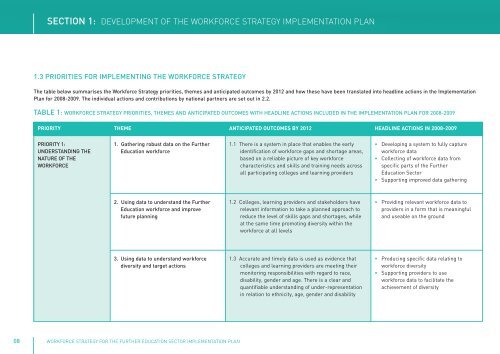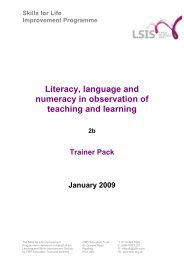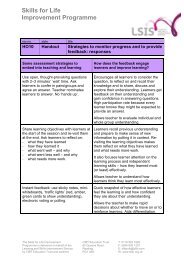IMPLEMENTATION PLAN - Skills for Life Improvement Programme ...
IMPLEMENTATION PLAN - Skills for Life Improvement Programme ...
IMPLEMENTATION PLAN - Skills for Life Improvement Programme ...
You also want an ePaper? Increase the reach of your titles
YUMPU automatically turns print PDFs into web optimized ePapers that Google loves.
SECTION 1: DEVELOPMENT OF THE WORKFORCE STRATEGY <strong>IMPLEMENTATION</strong> <strong>PLAN</strong><br />
1.3 PRIORITIES FOR IMPLEMENTING THE WORKFORCE STRATEGY<br />
The table below summarises the Work<strong>for</strong>ce Strategy priorities, themes and anticipated outcomes by 2012 and how these have been translated into headline actions in the Implementation<br />
Plan <strong>for</strong> 2008-2009. The individual actions and contributions by national partners are set out in 2.2.<br />
TABLE 1: WORKFORCE STRATEGY PRIORITIES, THEMES AND ANTICIPATED OUTCOMES WITH HEADLINE ACTIONS INCLUDED IN THE <strong>IMPLEMENTATION</strong> <strong>PLAN</strong> FOR 2008-2009<br />
PRIORITY THEME ANTICIPATED OUTCOMES BY 2012 HEADLINE ACTIONS IN 2008-2009<br />
PRIORITY 1:<br />
UNDERSTANDING THE<br />
NATURE OF THE<br />
WORKFORCE<br />
1. Gathering robust data on the Further<br />
Education work<strong>for</strong>ce<br />
1.1 There is a system in place that enables the early<br />
identification of work<strong>for</strong>ce gaps and shortage areas,<br />
based on a reliable picture of key work<strong>for</strong>ce<br />
characteristics and skills and training needs across<br />
all participating colleges and learning providers<br />
• Developing a system to fully capture<br />
work<strong>for</strong>ce data<br />
• Collecting of work<strong>for</strong>ce data from<br />
specific parts of the Further<br />
Education Sector<br />
• Supporting improved data gathering<br />
2. Using data to understand the Further<br />
Education work<strong>for</strong>ce and improve<br />
future planning<br />
1.2 Colleges, learning providers and stakeholders have<br />
relevant in<strong>for</strong>mation to take a planned approach to<br />
reduce the level of skills gaps and shortages, while<br />
at the same time promoting diversity within the<br />
work<strong>for</strong>ce at all levels<br />
• Providing relevant work<strong>for</strong>ce data to<br />
providers in a <strong>for</strong>m that is meaningful<br />
and useable on the ground<br />
3. Using data to understand work<strong>for</strong>ce<br />
diversity and target actions<br />
1.3 Accurate and timely data is used as evidence that<br />
colleges and learning providers are meeting their<br />
monitoring responsibilities with regard to race,<br />
disability, gender and age. There is a clear and<br />
quantifiable understanding of under-representation<br />
in relation to ethnicity, age, gender and disability<br />
• Producing specific data relating to<br />
work<strong>for</strong>ce diversity<br />
• Supporting providers to use<br />
work<strong>for</strong>ce data to facilitate the<br />
achievement of diversity<br />
08 WORKFORCE STRATEGY FOR THE FURTHER EDUCATION SECTOR <strong>IMPLEMENTATION</strong> <strong>PLAN</strong>

















